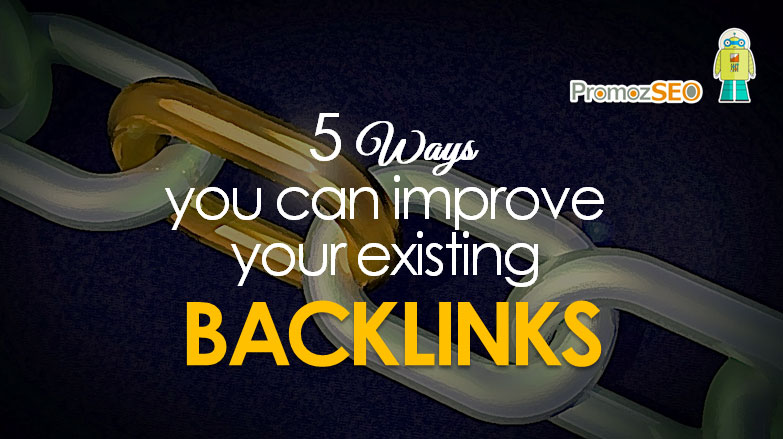5 Ways You Can Improve Your Website’s Existing Backlinks

If you’re in any way familiar with Search Engine Optimization (SEO), backlinks will very likely enter your discussions frequently. Indeed, backlinks have been a cornerstone of SEO for years, and it’s easy to see why.
In terms of SEO, among other benefits, they help inform search engines on what your content is all about. They produce off-page signals that boost your chances to rank higher in search engine results pages (SERPs).
In the case of Follow links, they increase your Domain Authority (DA) by lending it credibility. Even outside of SEO, both Follow and NoFollow backlinks produce traffic, enhancing conversions and sales.
But backlink strategies are also liable to change, as SEO itself changes over time and adapts to the evolving algorithms. Moreover, old backlinks are frequently forgotten and left to underperform as these changes occur. So, while building new backlinks is undoubtedly beneficial, why not also try to update and improve your existing backlinks?
Improving Your Existing Backlinks
So, first and foremost, let us define our terms. “Improvement” can entail a million different things and require just as many different practices to implement. That SEO rules outline so many different approaches to follow doesn’t help define an exact path either.
In this context, then, there are two main ways to approach “improving your existing backlinks”:
- Improve the effectiveness of your existing backlinks, and
- Promote and improve your existing content to get more backlinks.
Here, we will touch on both. Such practices will involve on-page activities like anchor changes, off-page activities like content promotion, and even strategic content creation. You may, of course, choose to explore any that you wish – but all should be worth some of your time.
Let us highlight five main ways to improve your existing backlinks and expand accordingly.
#1 Change Mentions into Backlinks
Many articles on backlinks will frequently begin with this suggestion, and for a good reason – it’s absolutely crucial. It is likely the single most straightforward way to acquire backlinks for which you’ve already done the work.
It is relatively common that brand mentions go unlinked, and there are multiple potential reasons for this:
- Lack of editorial value
- Link limits
- Plain oversights
But regardless of the reason, every mention offers the opportunity for a backlink. It does not require additional work; you’ve created your content, promoted it, and brought it to writers’ attention. As such, you may reach out and politely ask for a backlink in place of the mention.
Consider an email like this:
“Hi [name],
I hope this email finds you well. I’m [name], [position at website].
I was researching [subject], and I stumbled into your article on [subject]: [article link or title]. Excellent work, I must say.
I saw you also mentioned our [brand name or article title] in it. While we really appreciate the mention, could you perhaps add a hyperlink to our [website or work]? It would add value for your readers and let them find out more about [subject].
Again, the stellar work that you cited us was most appreciated.
All the best,
[your name]. “
As with all professional communication, politeness is key. As long as you don’t appear overly insistent or demanding of a link, most webmasters would likely oblige. Still, to ensure success, you may also want to demonstrate the editorial value that a hyperlink to you would provide.
Monitor Your Backlinks
To locate such mentions, however, you will need to monitor your backlinks. This is a necessity for other practices as well, such as updating or refining content in due time. Naturally, it’s also an invaluable asset toward improving your existing backlinks.
Fortunately, there are many tools to help you monitor and manage your links hassle-free. Some of the most notable ones include:
- LinkResearchTools
- Awario
- Ahrefs
- SocialMention
- SEMRush
- Mention
- HootSuite
- Ubersuggest
- Talkwalker Alerts
- Moz Pro Tools
Of course, each of these solutions will offer different functionalities and different potential uses. Moreover, they also come with different price tags, particularly important if you run a small-to-midsize business (SMB). Thus, you should carefully examine them and decide which can offer you the most value across your backlink strategy.
#2 Change NoFollow Links to Follow Links
Similarly, NoFollow links also offer a way to improve your existing backlinks by simply changing them to Follow links. This step too merely requires that you identify said links and contact the linking pages’ owners. Now, doing so may not seem very productive at a glance; all links generate traffic, after all. However, as Moz explains, not all links are created equal. Follow links are much more valuable, as they add to your website’s credibility and Domain Authority (DA).
Fortunately, you won’t need to check each and every backlink’s HTML manually. Many tools can help you detect NoFollow links, both as standalone tools and browser extensions. For the former, consider the following, among others:
In HTML, a Follow link will look like this:
<a href=”https://example.com”>example anchor text</a>
Instead, a NoFollow link will be like this:
<a href=”https://example.com” rel=”nofollow”>example anchor text</a>
Some of the tools that will help you identify the NoFollow links are,
- Ahrefs
- Moz Pro Tools
- Neil Patel’s Backlinks checker
- Backlink Checker
- Link Analyzer
- Varvy SEO
As regards browser extensions, you may consider some like the following:
- SEOquake (Chrome and Firefox)
- Moz’s MozBar (Chrome)
- Nofollow Link Checker (Chrome)
Maintain a Balance between NoFollow and Follow Links
Still, while Follow links are indeed more valuable, you won’t need to eliminate NoFollow links to improve your existing backlinks. On the contrary, you will need to strike a balance between the two to maintain a natural-looking backlink profile. Google may suspect foul play if all your links are Follow, and penalize your website because of it.
That’s not to say you should maintain a 50-50 ratio by any means. Instead, you could use such tools as LinkResearchTools’s Competitive Landscape Analyzer (CLA) or similar solutions to observe your competitors. If their SEO efforts are successful and their websites rank high, their link ratio should give you a glimpse of why. In turn, you could try to approach their ratio to blend in that regard.
#3 Reclaim Dropped Links
Finally, as regards contacting backlink sources, you may opt to reclaim dropped links. If you’re improving your existing backlinks, why not try to restore ones you’ve lost but for which you’ve done the work? Link reclamation can be extremely valuable, as Ahrefs has noted.
Inbound links may have been dropped for a plethora of reasons. Those may be related to any of the following:
- The author removed your backlink manually due to content quality and relevance, negative user feedback, failure to adhere to backlink guidelines in the case of user-generated content (UGC), etc.
- The link gets redirected
- The linking page no longer exists
Typically, links that have been removed manually can’t be easily reclaimed. You may contact the admin about it, offering to improve the previously linked content or otherwise meet their criteria. But in most cases, those links have likely been lost for good.
The other two cases are much simpler to address, however. First, you will need to use a tool like the following to identify dropped links:
- Majestic
- Ahrefs Site Explorer
- SEO Review Tool’s Free Backlink Checker
Then, you may contact web admins with the appropriate information, such as a page’s new URL. In most cases, they’ll be glad to hear from you, too – broken links don’t favor their websites either.
Reclaim Image Links
In much the same way, image links are also a valuable subset of backlinks. As above, you may lose image links over time – or have unlinked mentions, for that matter.
You may find images you’ve produced across the web by using reverse image search tools. Those can be ones provided by major search engines or platforms, including:
- Google Image Search
- Bing Visual Search
- Yahoo Image Search
- Pinterest Visual Search Tool
Alternatively, you may use other standalone tools like the following:
- Getty Images
- Picsearch
- TinEye Reverse Image Search
- PREPOSTSEO
In both cases, a reverse image search should reveal where your image has been used. Should you identify unlinked photos, or ones with broken links, you may contact administrators about it.
#4 Improve Link Source Content
Contacting others aside, you may also improve your existing backlinks by enhancing the content that contains them. Beyond contacting webmasters about modifications to their pages, you will typically have access to link source content if:
- the link source website belongs to you, or
- it is an internal link.
In either case, framing your link with better content can be an excellent way to increase its value and potency. SEO rightfully holds that “quality is king”, and backlink content is no exception. Better content linking to you will entail more impressions, as said content ranks higher, and thus more conversions.
To improve link source content, you may adhere to standard content creation and SEO best practices, such as:
- Enhancing your content’s factual accuracy and readability and refining its tone.
- Refining, or providing, meta text; image alt. tags, meta descriptions, etc.
- Providing more and more valuable images across longer texts.
- Achieving higher word counts – SEO practitioners will suggest between 1,000 and 2,000+ words.
- Optimizing keyword density; Yoast argues that 1 keyword for every 250 words is a safe minimum density.
These practices won’t simply let you improve your existing backlinks, either. They will also improve your SEO, in the case of internal pages, and refine your content creation. In turn, you may engage in the skyscraper technique to acquire new backlinks or claim broken links.
The Skyscraper Technique and Claiming Broken Links
The Skyscraper technique, coined by Backlinko’s Brian Dean, is simple enough at its core:
- Find websites that host content within your field.
- Improve on the content they host and add value.
- Contact them with your content offer.
While this technique will mostly see use in acquiring new backlinks, you may also use it for the practices mentioned above. For example, you may use it to ask for a NoFollow link to become a Follow one or reclaim a dropped link.
Finally, you may use it to claim broken links – or engage in broken link building if your content suffices. In this case, too, the process is relatively simple:
- Identify a website that contains a broken link
- Contact the webmaster about changing it to a link to your content
Through this simple but commonly overlooked process, you may acquire backlinks through existing content. And in this case, too, web admins will likely welcome your suggestion. After all, repairing broken links adds value to their websites too.
#5 Promote Your Linking Content
Finally, as with all matters SEO, content promotion matters. Marketers will attest to this, as brand awareness is now arguably more crucial than ever. However, in this context, it won’t just boost your lead acquisition rates; it will also improve your existing backlinks.
To do so, you may consider tried-and-tested promotion strategies like the following:
- Social media promotion and influencer marketing.
- Retargeting with Paid Social.
- Using PR tactics on-page and off-page.
- Repurposing and updating promoted content.
This is likely among the most straightforward suggestions on this subject; promoting content with your backlinks is an excellent strategy. If it’s your pages, you’re promoting your own content. If it’s content of other pages, you’re paving the way for professional relationships while promoting your backlinks.
Build Links to Your Link Sources
Finally, you may also consider building links to your link sources. However, this tactic does take time, and it may not yield the same results as other suggestions here.
To put it simply, you may create content that links to content that carries backlinks for you. While direct links are often preferable, some webmasters may be reluctant to do so. In those cases, you may leverage the authority of websites that do link to you and link to them instead.
Final Words on Improving Your Existing Backlinks
To summarize, there are many ways to improve your existing backlinks. You may frame them with better content, promote them more, or offer them substitutes for broken links. You may reclaim lost links, be they content or images, or claim unlinked mentions. You may even try to turn NoFollow links to Follow ones to suit your backlink profile better. But in all cases, doing so ensures your current work yields the results and benefits you’ve already worked for.
An advanced All-in-One Digital Marketing Course.
Mentored by Mr. Soumya Roy, the Founder, CEO of PromozSEO Web Marketing Academy.
- Reasons Your Business Needs to be on Instagram - September 16, 2021
- 7 Reasons Your Business Should Invest in Professional Content Creation - August 12, 2021
- 5 Ways You Can Improve Your Website’s Existing Backlinks - April 30, 2021





